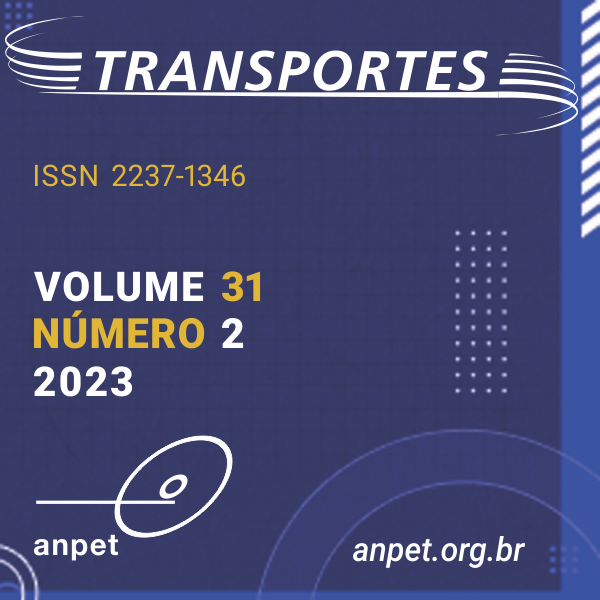Modelagem da duração de acidentes de trânsito em vias urbanas com alta variabilidade de tráfego usando modelos de sobrevivência: estudo de caso das vias arteriais de Fortaleza
DOI:
https://doi.org/10.58922/transportes.v31i2.2837Palavras-chave:
Acidentes de trânsito, congestionamento não-recorrente, análise de sobrevivênciaResumo
Congestionamentos inesperados são um problema frequente na vida de habitantes de grandes centros urbanos que precisam se deslocar para realizar suas atividades. Esse tipo de congestionamento causa atrasos imprevistos aos motoristas e tem os acidentes de trânsito e a sua duração como principal fator para sua formação. Visando contribuir com essa problemática, este estudo teve como objetivo analisar a duração de acidentes de trânsito ocorridos em vias arteriais de Fortaleza, Brasil, e a sua relação com seus fatores causais. Uma vez que não existem dados disponíveis com a duração desses acidentes, foram utilizados dados de tráfego, obtidos de equipamentos de fiscalização eletrônica, para extrair essa informação de forma indireta. Para isso, foram gerados perfis da velocidade e proporção do fluxo veicular por faixa no dia do acidente e em dias típicos para diferenciar o impacto causado no tráfego por um acidente de trânsito de suas variações normais. Ao final, foi obtida uma amostra de 316 acidentes com uma duração média de 71 minutos e um desvio padrão de 43 minutos. Em seguida, foram levantadas hipóteses sobre potenciais fatores causais da variabilidade observada na duração dos acidentes, as quais foram testadas usando modelos de sobrevivência. O modelo calibrado mostrou que a severidade do acidente, as condições de tráfego no local do acidente, a quantidade e programação dos agentes de trânsito e o número de veículos envolvidos no acidente possuem uma influência significativa na duração dos acidentes.
Downloads
Referências
Haule, H.J.; T. Sando; R. Lentz et al. (2018) Evaluating the impact and clearance duration of freeway incidents. International Journal of Transportation Science and Technology, v. 8, n. 1, p. 13-24. DOI: 10.1016/j.ijtst.2018.06.005. DOI: https://doi.org/10.1016/j.ijtst.2018.06.005
Hojati, A. T.; Ferreira, L.; Charles, P. et al. (2012) Analysing freeway traffic-incident duration using an Australian data set, Road and Transport Research, v. 21, n. 2, p. 19-31.
Hojati, A. T.; L. Ferreira; S. Washington et al. (2013) Hazard based models for freeway traffic incident duration, Accident Analysis and Prevention, v. 52, p. 171-81. DOI: 10.1016/j.aap.2012.12.037. PMid:23333698. DOI: https://doi.org/10.1016/j.aap.2012.12.037
Hojati, A. T.; L. Ferreira; S. Washington et al. (2014) Modelling total duration of traffic incidents including incident detection and recovery time, Accident Analysis and Prevention, v. 71, p. 296-305. DOI: 10.1016/j.aap.2014.06.006. DOI: https://doi.org/10.1016/j.aap.2014.06.006
Hou, L.; Y. Lao; Y. Wang et al. (2014) Time-varying effects of influential factors on incident clearance time using a nonproportional hazard-based model. Transportation Research Part A, Policy and Practice, v. 63, p. 12-24. DOI: 10.1016/j.tra.2014.02.014. DOI: https://doi.org/10.1016/j.tra.2014.02.014
IBGE (2020) Brazilian Census of 2020. Available at: <https://cidades.ibge.gov.br/brasil/ce/fortaleza/panorama> (accessed 05/25/2023).
Junhua, W.; C. Haozhe and Q. Shi (2013) Estimating freeway incident duration using accelerated failure time modeling, Safety Science, v. 54, p. 43-50. DOI: 10.1016/j.ssci.2012.11.009. DOI: https://doi.org/10.1016/j.ssci.2012.11.009
Khattak, A.J.; J. Liu; B. Wali et al. (2016) Modeling traffic incident duration using quantile regression, Transportation Research Record: Journal of the Transportation Research Board, v. 2554, n. 1, p. 139-48. DOI: 10.3141/2554-15. DOI: https://doi.org/10.3141/2554-15
Khattak, A.J.; J.L. Schofer and M. Wang (1995) A simple time sequential procedure for predicting freeway incident duration, IVHS J., v. 2, n. 2, p. 113-38. DOI: 10.1080/10248079508903820. DOI: https://doi.org/10.1080/10248079508903820
Kleinbaum, D.G. and M. Klein (2012) Survival Analysis: A Self-Learning Text (3th ed.). New York: Springer. DOI: 10.1007/978-1-4419-6646-9. DOI: https://doi.org/10.1007/978-1-4419-6646-9
Lee, J.; J. Chung and B. Son (2010) Incident clearance time analysis for Korean freeways using structural equation model, Journal of the Eastern Asia Society for Transportation Studies, v. 8, n. 1, p. 1878-91. DOI: 10.11175/eastpro.2009.0.360.0.
Li, R. (2015) Traffic incident duration analysis and prediction models based on the survival analysis approach, IET Intelligent Transport Systems, v. 9, n. 4, p. 351-8. DOI: 10.1049/iet-its.2014.0036. DOI: https://doi.org/10.1049/iet-its.2014.0036
Li, R.; F.C. Pereira and M.E. Ben-Akiva (2018) Overview of traffic incident duration analysis and prediction, European Transport Research Review, v. 10, n. 22, p. 22. DOI: 10.1186/s12544-018-0300-1. DOI: https://doi.org/10.1186/s12544-018-0300-1
Li, R.; M. Guo; H. Lu et al.(2017) Analysis of the different duration stages of accidents with hazard-based model. International Journal of Intelligent Transportation Systems Research, v. 7, n. 16, p. 7-16. DOI: 10.1007/s13177-015-0115-6. DOI: https://doi.org/10.1007/s13177-015-0115-6
Nam, D. and F. Mannering (2000) An exploratory hazard-based analysis of highway incident duration, Transportation Research Part A, Policy and Practice, v. 34, n. 2, p. 85-102. DOI: 10.1016/S0965-8564(98)00065-2. DOI: https://doi.org/10.1016/S0965-8564(98)00065-2
Shi, Y.; L. Zhang and P. Liu (2015) Survival analysis of urban traffic incident duration: a case study at shanghai expressways, Journal of Computing, v. 26, n. 1, p. 29-39. Available at: <http://www.csroc.org.tw/journal/JOC26- 1/JOC26-1-3.pdf> (accessed 05/25/2023)
Skabardonis, A.; P. Varaiya and K. Petty (2003) Measuring recurrent and nonrecurrent traffic congestion. Transportation Research Record: Journal of the Transportation Research Board, v. 1856, n. 1, p. 118-24. DOI: 10.3141/1856-12. DOI: https://doi.org/10.3141/1856-12
Souza, V.N. and F.M. Oliveira Neto (2020) Analysis of accident duration on urban arterials roads, TRANSPORTES, v. 28, n. 3, p. 266-80. DOI: 10.14295/transportes.v28i3.2142. DOI: https://doi.org/10.14295/transportes.v28i3.2142
Valenti, G.; M. Lelli and D. Cucina (2010) A comparative study of models for the incident duration prediction, European Transport Research Review, v. 2, n. 2, p. 103-11. DOI: 10.1007/s12544-010-0031-4. DOI: https://doi.org/10.1007/s12544-010-0031-4
Washington, S.P.; M.G. Karlaftis and F.L. Mannering (2003) Statistical and Econometric Methods for Transportation Data Analysis. New York: Chapman & Hall/CRC. DOI: 10.1201/9780203497111. DOI: https://doi.org/10.1201/9780203497111
Xie, K.; K. Ozbay and H. Yang (2015) Spatial analysis of highway incident durations in the context of Hurricane Sandy, Accident Analysis and Prevention, v. 74, p. 77-86. DOI: 10.1016/j.aap.2014.10.015. PMid:25463947. DOI: https://doi.org/10.1016/j.aap.2014.10.015
Zhang, H. and A.J. Khattak (2010) Analysis of cascading incident event durations on urban freeways, Transportation Research Record: Journal of the Transportation Research Board, v. 2178, n. 1, p. 30-9. DOI: 10.3141/2178-04. DOI: https://doi.org/10.3141/2178-04
Downloads
Publicado
Como Citar
Edição
Seção
Licença
Copyright (c) 2023 Vandeyberg Nogueira de Souza, Francisco Moraes de Oliveira Neto

Este trabalho está licenciado sob uma licença Creative Commons Attribution 4.0 International License.
Ao submeter um manuscrito para publicação neste periódico, todos os seus autores concordam, antecipada e irrestritamente, com os seguintes termos:
- Os autores mantém os direitos autorais e concedem à Transportes o direito de primeira publicação do manuscrito, sem nenhum ônus financeiro, e abrem mão de qualquer outra remuneração pela sua publicação pela ANPET.
- Ao ser publicado pela Transportes, o manuscrito fica automaticamente licenciado sob a Licença Creative Commons CC BY 4.0. Esta licença permite o seu compartilhamento com reconhecimento da autoria e da publicação inicial neste periódico.
- Os autores têm autorização para assumir contratos adicionais separadamente, para distribuição não exclusiva da versão do trabalho publicada neste periódico (por ex.: publicar em repositório institucional ou como capítulo de livro), com reconhecimento da publicação inicial na Transportes, desde que tal contrato não implique num endosso do conteúdo do manuscrito ou do novo veículo pela ANPET.
- Os autores têm permissão e são estimulados a publicar e distribuir seu manuscrito online (por ex.: em repositórios institucionais ou na sua página pessoal) depois de concluído o processo editorial. Como a Transportes é de acesso livre, os autores são estimulados a usar links para o DOI do artigo nesses casos.
- Os autores garantem ter obtido a devida autorização dos seus empregadores para a transferência dos direitos nos termos deste acordo, caso esses empregadores possuam algum direito autoral sobre o manuscrito. Além disso, os autores assumem toda e qualquer responsabilidade sobre possíveis infrações ao direito autoral desses empregadores, isentando a ANPET e a Transportes de toda e qualquer responsabilidade neste sentido.
- Os autores assumem toda responsabilidade sobre o conteúdo do manuscrito, incluindo as devidas e necessárias autorizações para divulgação de dados coletados e resultados obtidos, isentando a ANPET e a Transportes de toda e qualquer responsabilidade neste sentido.











